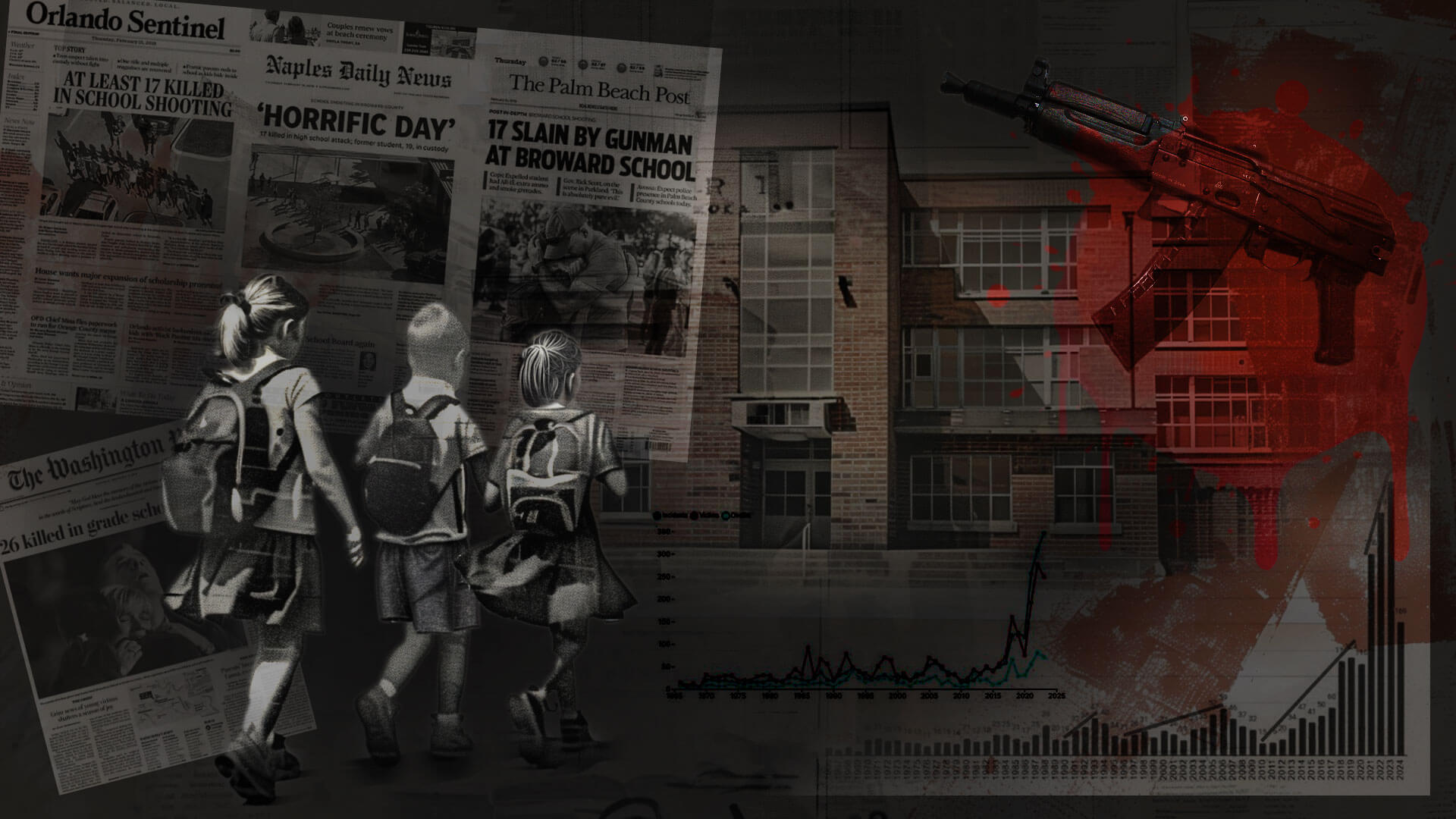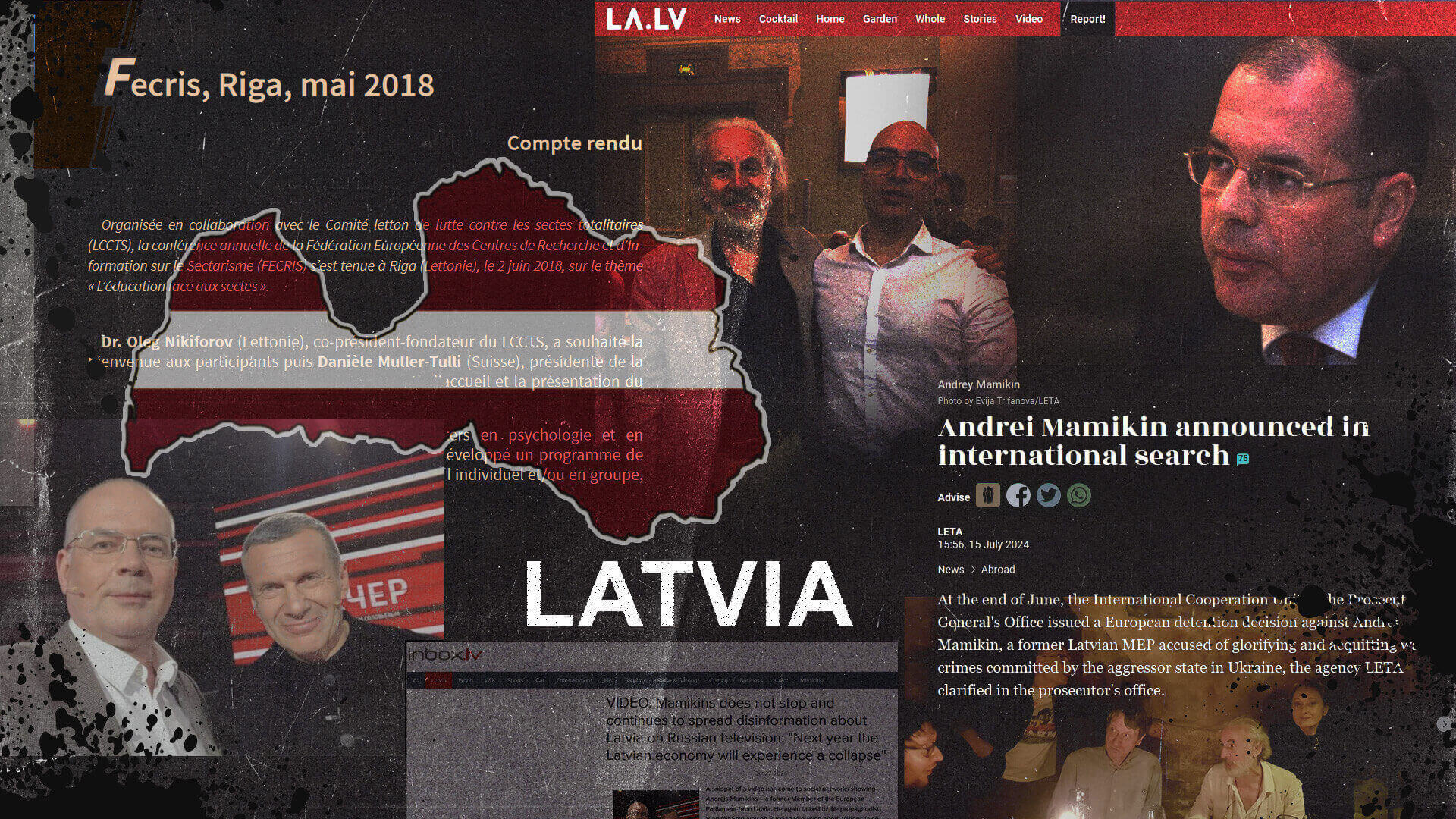We are beginning a series of articles dedicated to fighting anticult organizations in Italy. While browsing the Internet, we came across a Libero Credo website www.liberocredo.org 1. The analytical materials collected therein recount violations of human civil rights related to freedom of religion, thought and expression; violations of the Constitution of the Italian Republic, in particular articles 3, 8, 19, 20 and 21. They also describe subversive terrorist activities perpetrated by the same anticultists, the subject of our study, who are waging endless campaigns to undermine religions and small religious groups throughout Europe.
Libero Credo
Articles on the Libero Credo website are written in the spirit of independent investigative journalism and quite coincide with our understanding of the topic, so we believe it is necessary to summarize some of them in a shortened form.
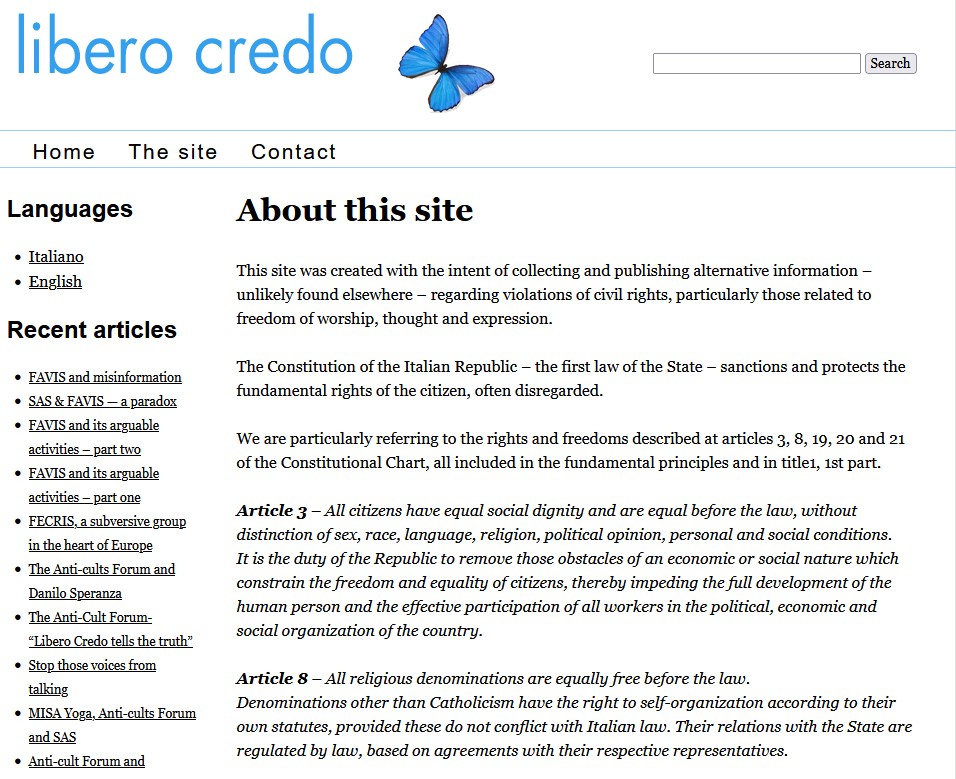
Let’s review the article “FECRIS, a subversive group in the heart of Europe” 2.
Affiliated members of the international anticult organization FECRIS, which is funded from the French government’s budget and closely associated with the Russian RACIRS, used to kidnap people for the purpose of “deprogramming”, and in Italy they are now organized as a specialized group of libellers.
The anticultists’ campaign of hatred and intolerance has its instigators and financiers. It’s time to cast one’s eyes beyond the ranks of the soldiery of which we have spoken so far, in order to see who is running them.
Let’s make a brief introduction to summarize the general lines of what we already know of the Italian actors, to then move on to the true subject of this article.
Anti-Cult FORUM
The Italian associations forming the so-called Anti-Cult FORUM (FAVIS, CeSAP, ARIS Veneto and ARIS Toscana) and that cooperate with the Anti-Cult Squad (S.A.S.) of the Ministry of Interior, are the laborers, the marginal executors of a system organized to overcome – violating them – the constitutional limits that were erected to defend the freedom of belief, thought and expression.
Their aim is to bring about an anticult hysteria. They do it, constantly spreading alarming news. They alter, swell and twist information and statistics to make people believe that in Italy there are thousands of “dangerous cults” – practically one around each corner – that swindle hundreds of thousands of ordinary people and dupe millions of incapables. When there is no news they can alter, they invent some out of whole cloth.
It should be noted that the same things were happening in Russia where for the last 30 years anticult hysteria was being stirred up by the hands of RACIRS (Russian Association of Centers for the Study of Religions and Sects) as well as in France.
It’s enough to take a look at the myriad of weird “news” releases, at the hundreds of lectures, debates, conferences and seminars they constantly organize to launch their alarming messages and then compare them to the day-to-day life and events to understand that we are facing an organized campaign designed to transform a non-issue, into a real one. Always the same people, always the same associations, year after year, decade after decade, and always the same four cats repeating same old stories and gathering in conventions and congresses in front of the usual “speakers” and “experts”.
Mission: repeat ad nauseam that “cults are dangerous, they are everywhere, they are destructive and they must be absolutely eliminated.” Anytime, anywhere, anyhow for omnia secula seculorum. Hysteria, this is the goal, like in other times hysteria against witches, heretics and Jews was sown.
In the 80s and 90s, the founders of the anticult groups were involved in kidnapping aimed to “deprogram” through violence and coercion followers of religious groups. The alarming media campaigns inciting hatred against “cults” made it possible to resort to kidnapping and deprogramming without suffering serious legal repercussions, at least initially. Now they vainly deny that past.
Then times have changed, and after some complaints and some trials, the anticultists have abandoned the deprogramming and changed strategy.
GRIS
As we all know, those listed are not the only anticult groups operating in our country. There are others – more or less secular – small associations and then there is the Catholic golem called GRIS (Group of Socio-Religious Research and Information – formerly the “S” stood for Sects, but was later on replaced with the more politically correct “Socio-Religious”).
Funded and supported by the diocese and officially recognized by Cardinal Camillo Ruini, President of the CEI (Italian Episcopal Conference), GRIS was created to defend “the wine of the Catholic inn” arguing how dangerous and counterfeit is that of the “non-Catholic ones.”
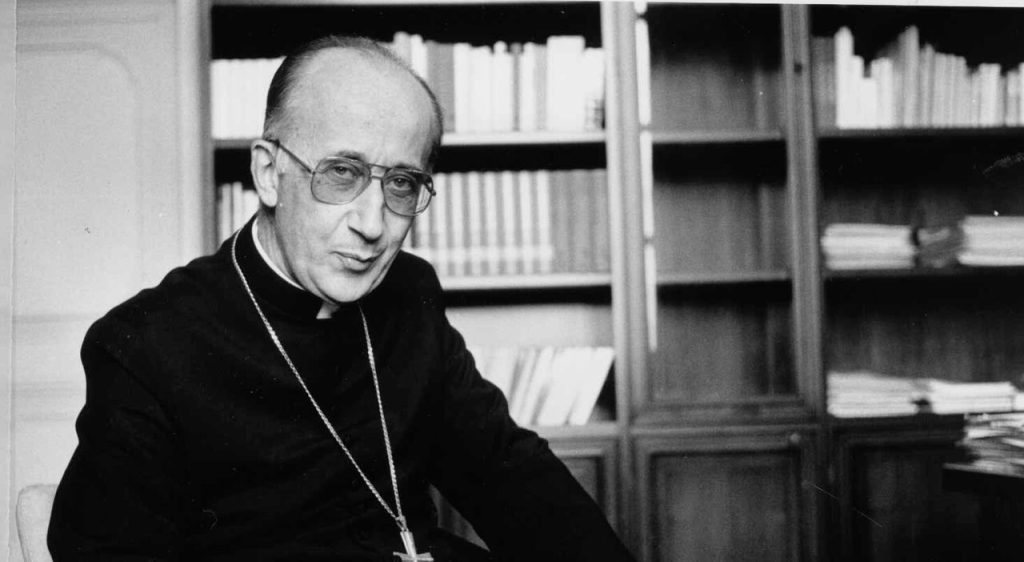
Officially GRIS has no connections with the S.A.S., but the relationship is very close, if we consider that the official contact of S.A.S. is the Catholic priest don Aldo Buonaiuto (“The Anti-cult Squad”).
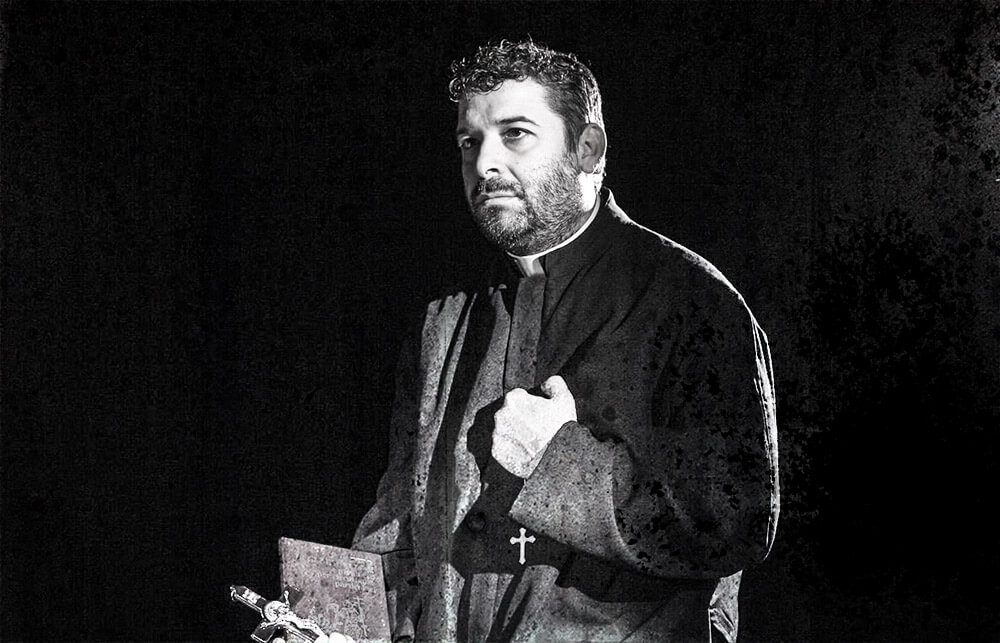
Moreover, the S.A.S. was born as a result of Catholic pressures, at least according to what Maurizio Alessandrini of FAVIS wrote on July 14, 2009 to the then President of the Senate Renato Schifani.
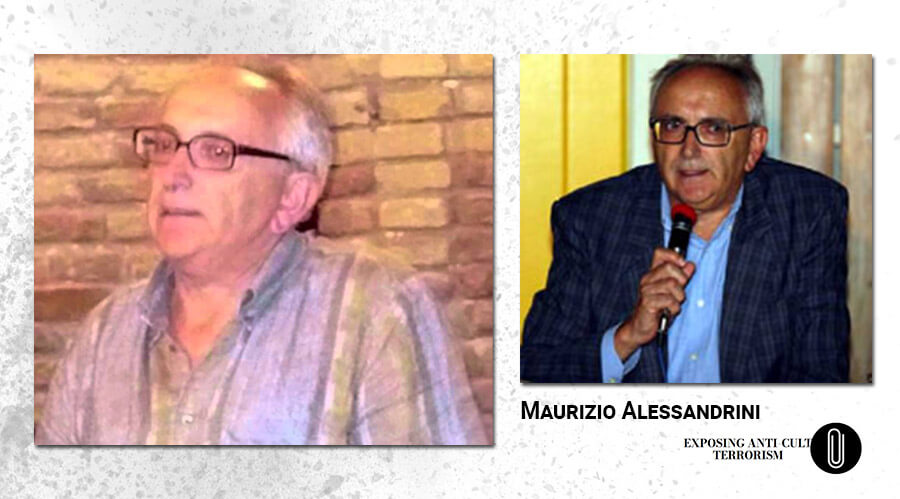

S.A.S., although an official government body funded with taxpayers’ money, is only the executive arm of this plan that strongly smells of unconstitutionality.
Alike in the past centuries, the hatemongers (the anticultists) unleash ideological fanaticism against alleged social dangers to spread alarm and fears in order to trigger panic. Then the cops of the civil authorities give play to the persecutions that nowadays, rather than with auto-da-fé, are carried out through media shackles and farcical and specious trials, no less violent than the deprogramming practiced by the first anticultists.
The Italian anticult associations, in particular those of the Anti-Cult Forum, are part of a European Federation called FECRIS.
FECRIS and Co.
FECRIS 3 is the Fédération Européenne del Centres de Recherche ed d’Information sur le Sectarism (European Federation of the Centers of Research and Information on Sectarianism), founded in Paris in 1994 and based in Marseille, with members and correspondents in some thirty countries.
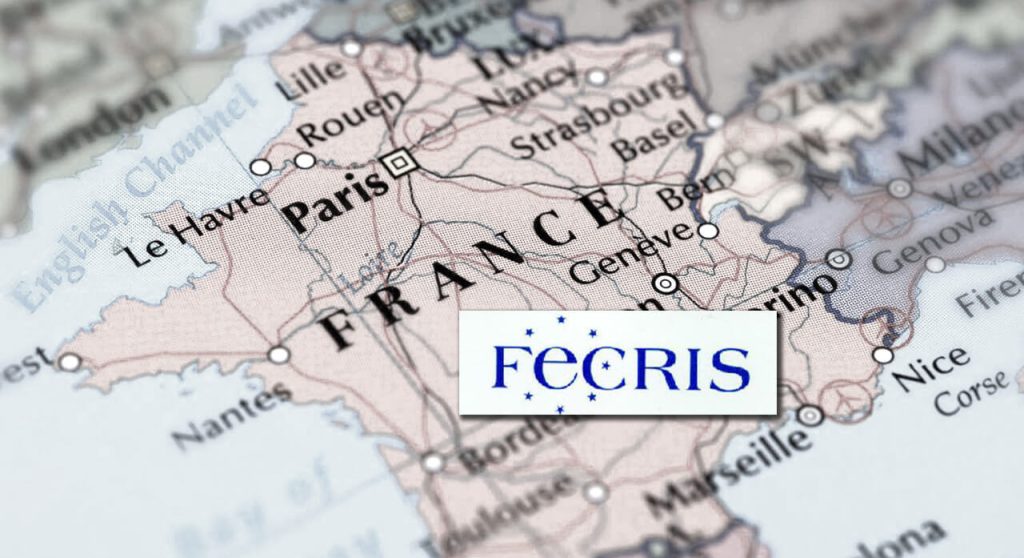
Although FECRIS is representing itself as a set of associations that spontaneously federated to defend human rights from “organizations with sectarian and totalitarian characteristics”, in reality it was created by two French anticult associations called CCMM (Centre Contre les Manipulationes Mental) 4 and UNADFI (Union Nationale des Associations de Défense de la Famille et de l’Individu) 5. In turn, these associations are organisms wanted and financed by some politicians who have exploited to this end their position within the French institutions and the government.
Before we continue speaking about FECRIS, let’s talk a bit about CCMM and UNADFI.

In the 90s the president of CCMM was Alain Vivien. When chairing this private anticult group, Vivien was at the same time a member of the French Parliament. His extremely alarming report against “cults” dates back to 1983 (but it was made public only in 1985). Such a document was very similar to the infamous report on cults of 1998 published by the Italian Ministry of Interior (“State Alarm”) 6.
Alain Vivien’s report on “Сults in France” recommended, among other things, the establishment of a government entity dealing with the “cult problem”. This entity was created in 1996 with the name of Observatoire Interministériel sur le Sectes (Inter- Ministerial Observatory on Cults). …Vivien became the president of this observatory in 1998 when its name got changed to Mission Interministerielle de Lutte Contre les Sectes (MILS – Inter-Ministerial Mission for the Fight against Cults).
The MILS depended directly from the French Prime Minister’s Office, had access to the funds allocated to various ministries and was working with the French Police and the Secret Services (RG — Renseignements Généraux). From his position as President of the MILS, Vivien established a stable public funding line both for CCMM and UNADFI.
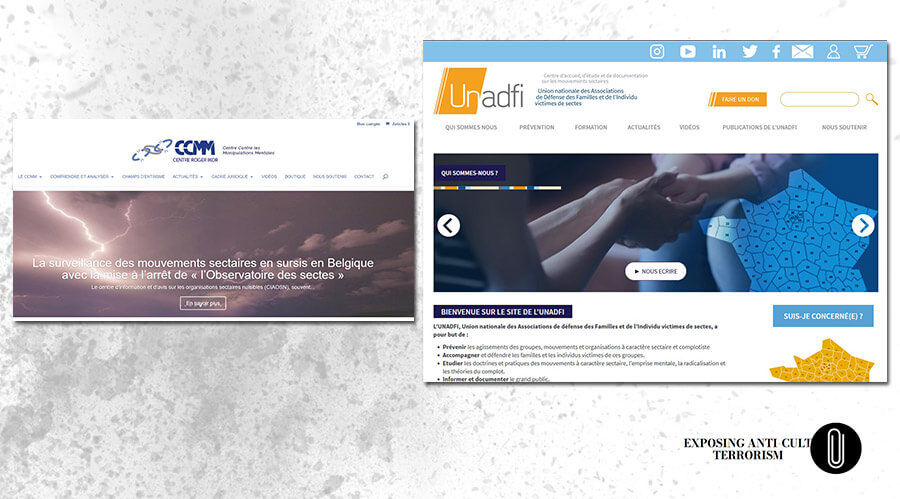
For its strongly repressive and discriminatory activity against religious movements, MILS was severely and repeatedly criticized by foreign observers, including the American State Department.
In November 2002, following financial scandals concerning the misuse of substantial funds allocated for the “fight against cults”, Vivien resigned and MILS was dismantled. Vivien had spent half the MILS budget for trips abroad, and other relevant amounts for the purchase of luxurious and useless buildings for UNADFI and CCMM.
MILS was replaced by MIVILUDES (Mission Interministérielle de Vigilance et de Lutte Contre le Dérives Sectaries) which, after a short period of adjustment, resumed the same activities of the MILS.
Here’s a chart showing the amount of funds which, for example, UNADFI received under Vivien’s management of the MILS 2:

Below, other charts showing the proportion of public funds received by UNADFI compared to the funds received from private subjects (donations and memberships): The same amount of funds was and is appropriated also to CCMM. Practically, UNADFI and CCMM (and now also FECRIS) receive the vast majority of their funding by the French government and only a minimal part by private citizens. 2
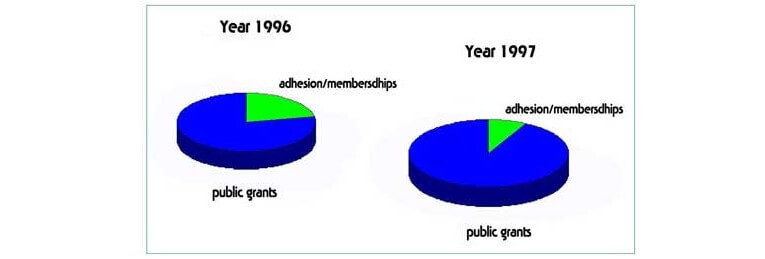
Operating all over the French territory, UNADFI and CCMM, have at their disposal a “catchment area” of over 66 millions of inhabitants. Citizens who, for decades, have been flooded with government-funded incessant and hammering media campaigns about the “danger of cults”.
Nevertheless, the private funds coming from memberships, donations and gifts in support of their work, represent only a tiny proportion of their revenues, which demonstrates that public appreciation for their activities is almost zero.
As an example, Medecins sans Frontieres, one of most renowned and respected NGOs in France, receives only 5% of their income from the government, while the vast majority of their funds comes from supporters, allies and associates.
On the contrary, UNADFI and CCMM receive over 97% of funding from public entities and less than 3% from private individuals and supporters. Here is the comparison:
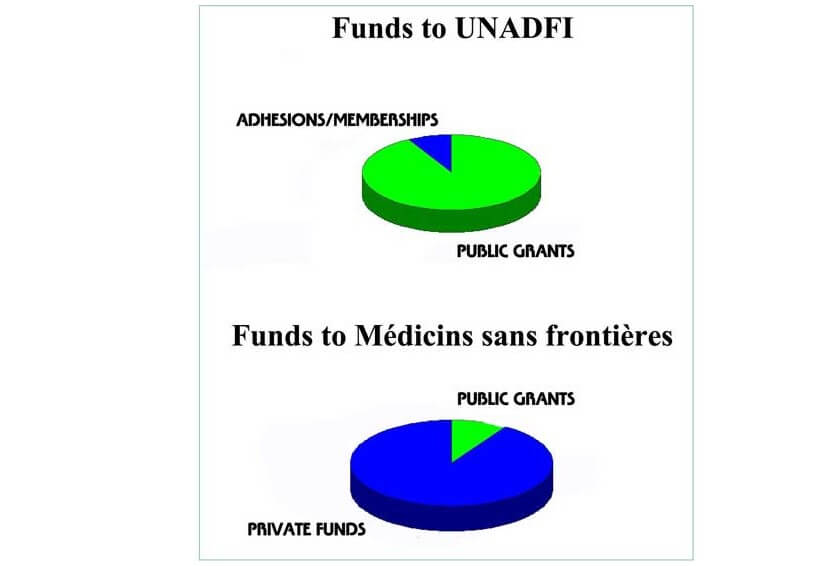
The above gives us an understanding of the environment that generated the modern European anticult movement.
In spite of financial scandals, international critics and the resignation of Alain Vivien, the MIVILUDES-UNADFI-CCMM partnership was working very well in France. Thanks to the generous public funding, over the years they have managed to create in France a real phobia about “cults” through media campaigns and official reports of the MIVILUDES based on “information” provided by CCMM e UNADFI.
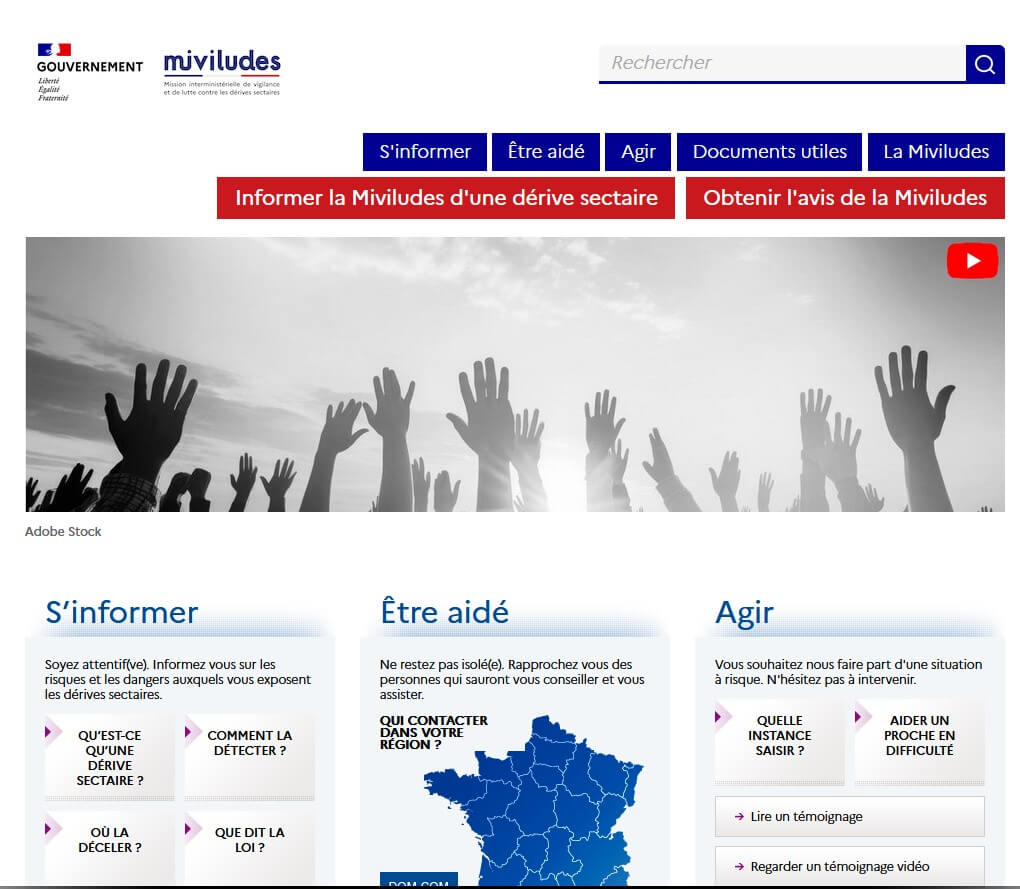
But France was isolated in Europe and widely criticized for the intolerant policy of a “too aggressive laity” in matter of religious freedom. A solution was needed to get the French model accepted and exported in other countries. The chosen solution was the creation of a European federation of anticultists controlled by France, FECRIS, in fact.
From the consultation of documents of a now disbanded and discredited American anticult association called CAN (Cult Awareness Network) 7, we learn that the idea of creating FECRIS dates back to 1987. This was discussed during an international conference sponsored by the American Family Foundation (AFF, the American anticult sister association of the deceased CAN) held in Barcelona, Spain.
The next International conference was held in Paris on 27 and 28 April 1990, hosted by the AFF and its French counterpart ADFI 8. Before the conference, the president of AFF Herbert L. Rosedale addressed the following letter of tank to Cynthia S. Kisser, the Executive Director of CAN:
“I want to express my appreciation to your association for having sent one of your representatives at the meeting that we, the American Family Foundation (AFF) and the Association pour la Defense des Families et de I’Individu (sic) (A.D.F.I.), will be holding in Paris … The purpose of the meeting is discussing the methods with which organizations dealing with education on cults can cooperate to achieve common benefits … it will be a meeting to begin a process of cooperative planning and thus publicity is not welcome”. 2

Herbert L. Rosedale chaired the meeting in Paris during which the plans were finalized and decisions were made to form an international anticult group. In fact, after the conference, Rosedale became the temporary president of the so-called “Consortium of groups” representing different nations.
Finally, on June 30, 1994, FECRIS was formed and registered with the French government entities. The director of ADFI Jacques Richard was chosen as the first president.
…At the time, Alain Vivien was the president of CCMM and he worked on the front line for the realization of this project. He held the office until the birth of MILS of which, as we saw, he assumed the presidency in 1998.
In addition to supporting the project for the creation of the Federation of European anticult associations, since the second half of the 80s, the leaders of CAN and AFF instructed the members of the anticult groups that later on formed the FECRIS on the “deprogramming” techniques.
In 1995, CAN was hit by dozens of criminal and civil cases stemming from numerous failed attempts of forced deprogramming. The legal troubles drained the energies and finances of the leaders of the CAN, until when, on October 23, 1996, the association closed its doors and underwent a procedure for bankruptcy, at the conclusion of which, its properties and archives were auctioned.

Even in the absence of CAN, AFF maintained and expanded its contacts with FECRIS.
After its incorporation, under the aegis of MIVILUDES and CCMM, FECRIS had immediate access to the same line of funding from the French government, which, as for the other two groups, began to assign to them annually appropriate amounts so that they could act as European disseminators of the anti-religious policy of that country.
FECRIS representatives are not clearly admitting this funding, but the documentation that follows, related to year 2006, proves its existence beyond any doubt.

As shown in the scheme that follows, compiled by FECRIS itself and which relates to years 2003-2008, FECRIS receives these grants year after year only from the French government and from no other entity of other countries. It cashes a small amount of money from the memberships and nothing else from private individuals.

The same thing has been happening each year, from the incorporation of FECRIS until today. Other funds, always coming from the French government, are made available for the activities of the federation led by FECRIS, through UNADFI and CCMM.
Obviously, these are not the only funds that all these French associations receive from that government. For example, as mentioned earlier, the scandal that engulfed Alain Vivien also related to the improper use of a large sum (around 700,000 euro of today) for the purchase of a property to be allocated to UNADFI and a similar amount spent on a building for CCMM.
If there were any doubt about the fact that the Italian associations federated with FECRIS (FAVIS, CeSAP, ARIS Toscana and ARIS Veneto) benefit of the French funds, here is an email that the current secretary of FECRIS Mireille Degen sent to them in occasion of the FECRIS conference of Warsaw in 2011.
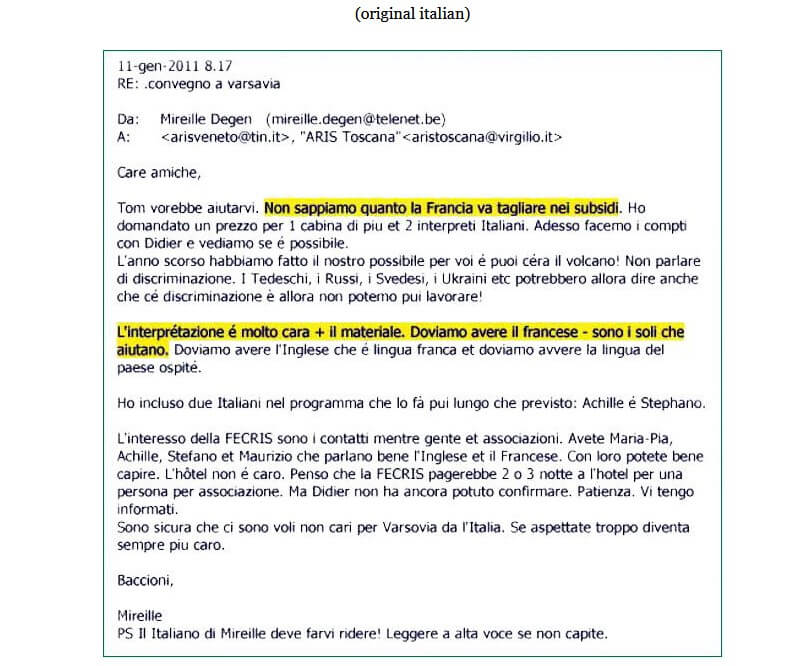

Although the law does not allow that associations funded by a government agency obtain the NGO status, the Council of Europe granted such accreditations to FECRIS in 2005, not without controversy from various sources throughout Europe.
Although public funding and accreditations at the Council of Europe and other organizations, the federation of associations belonging to FECRIS is, in fact, a sham, a half-empty shell. The appearance of branched and powerful organization is just that: an appearance.
Suffice it to say that the so-called General Secretary of FECRIS and representative of the office of Brussels, Mireille Degen, is a retired teacher and the registered seat of the Belgian FECRIS is the living room of her apartment, while the correspondent and treasurer of Marseille FECRIS, Didier Pachoud is a tram driver and the seat of the association, his guest room.
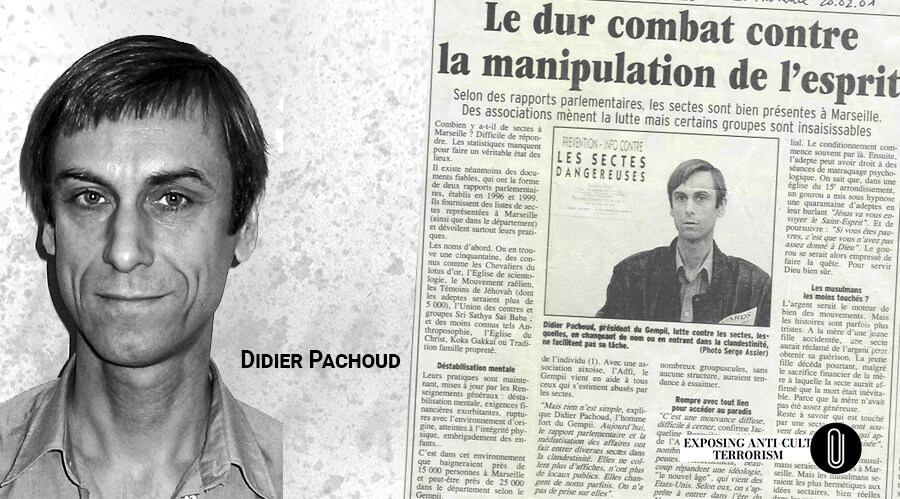
The scene is no different for the Italian anticult associations federated to FECRIS. They, too, like most of the associations belonging to the FECRIS, are actually tiny groups which, as we have seen above, thanks to the French public funds, participate in “international” conferences held at regular intervals in the various European Union countries.
It should be added that the members of FECRIS, widely lacking academic qualifications and professional skills, have, in their curricula, other “qualities” that make them at least unreliable. Here is a partial and not updated list of convictions and judgments issued against groups and representatives of FECRIS…
Major activities of those associations include manipulation of incidents related to “cults” and “sects” and the use of “fugitives” and apostates to confirm their anticult theories and create new reasons for media campaigns. In the course of their activities, anticultists involve irresponsible politicians who propose laws and resolutions hostile to religious movements, and they also incite prosecutors to initiate trials that can lead to unfair decisions even in case of failure.
Lawsuits against FECRIS
On June 8 and 9, 2005, the UN Conference on Anti-Semitism and Other Forms of Intolerance was held in Cordoba. The summary report provided a list of cases in which FECRIS members were convicted. Extracts or summaries of judgments concerning FECRIS member groups and individuals 10:

1. Friedrich Griess, Secretary General of FECRIS Court case: 17Cg 15/96d in Vienna Commercial court in Sept. 1996. Conviction for defamation about the Christian Family Fellowship, Styrian Christian Fellowship and the Life Fellowship (Norwegian Movement) including that they enlist people by “flirty fishing”, engage in incest, adultery and deceit.
2. Friedrich Griess, Secretary General of FECRIS Court case: 17Cg 15/96d in Vienna Commercial court in March 1997. Conviction for defamation with regard to the Christian Family Fellowship, Styrian Christian Fellowship and the Life Fellowship (Norwegian Movement) “Norwegians”.
3. Friedrich Griess, Secretary General of FECRIS Court case: 37Cg 77/98x in Vienna Commercial court on Sept. 1998. Conviction for defamation for alleging that the Christian Family Fellowship, Styrian Christian Fellowship and the Life Fellowship (Norwegian Movement). Fine of 60,000 Austrian shillings
4. Friedrich Griess, Secretary General of FECRIS Court case: 17 O 85/98 in Stuttgart County Court in Germany – June 1998. Conviction for defamation against the “Norwegian movement”
5. Friedrich Griess, Secretary General of FECRIS Court case: 37Cg 19/00y in Vienna Commercial court in March 2000. Conviction for defamation and ordered by court to publish a correction statement on his web page and establish a link to the web page of the Norwegian Movement.
6. Friedrich Griess, Secretary General of FECRIS Court case: GZ 8E 3407/00 w in Klosterneuburg District Court. Violation of settlement agreement. He did not pay a fine and was ordered to remove false information from his web page and from search engines.
7. Friedrich Griess, Secretary General of FECRIS Judgement procedure GZ 8F 2687/02 s-3 in Klosterneuburg District Court. Violation of settlement agreement and order to pay a fine.
8. SADK, 1990 [FECRIS member group], Switzerland In 1990, two members of FECRIS member group SADK were sentenced to prison in connection with a violent deprogramming attempt on a member of the Hare Krishna movement. Mr. Rossi, who at the time was the spokesman for SADK, spoke out loudly in favour of the deprogramming (during which the victim had been subdued with tear gas) saying “We support and approve of the deed.”
9. FRI, 1990 [FECRIS member group], Sweden Case Nr B4901-88, ref.Nr. 75636712, issued December 19, 1990. In this judgement FRI-member Eva Pehrsson (now Pohl) was sentenced for the illegal deprivation of liberty and kidnapping of Gustavsson.
10. FAIR, 1987 [FECRIS member group], United Kingdom Cyril Vosper, at the time an executive board member of FAIR, was convicted in Germany for false imprisonment and bodily harm in December 1987.
11. ADFI Paris [FECRIS member group] was condemned by the Paris County Court (Tribunal de Grande Instance) for defamation regarding Mrs. Josiane Henri and Mr. Ian Combe. (Decision RP 59 656, RG 7 987/92, ASS/20.02.92, CIVIL TRIAL COURT OF GENERAL JURISDICTION OF PARIS, 1st Chamber, 1st Section) 27th May 1992.
12. Mrs. Tavernier [President of a FECRIS member group]. 5th January 1994. Criminal conviction for defamation. The Paris Court of Appeal confirmed the judgment regarding the culpability of libel of Mrs. Tavernier and the punishment imposed on her by the Paris County court on 22nd June 1993. Decision n° 5490/93, APPEAL COURT OF PARIS, 11th Chamber on 5th January 1994
13. Mrs. Ovigneur-Dewynter, President of ADFI Nord [FECRIS member group],15th January 1997. The Douai Court of Appeal condemned Mrs. Ovigneur-Dewynter, President of ADFI Nord for defamation regarding the Cultural Association of the Jehovah’s Witnesses in France. Case N° 96/02832, Decision on January 15th, 1997, 4th Chamber, APPEAL COURT OF DOUAI
14. Jacky Cordonnier, [member of UNADFI, FECRIS member group]. 29th March 2002. Criminal conviction for defamation. The Marseille County Court condemned her for libel regarding the association of Jehovah’s Witnesses. Decision n° 2972/02 Number 01207964
15. Janine Tavernier President of UNADFI [FECRIS member group]. 5th February 2003. The Paris Court of Appeal confirmed the judgment in the civil proceedings against Janine Tavernier and UNADFI (decisions of the Paris County Court of 20 November 2001). Case N° 01/03757, Decision of February 5th, 2003, APPEAL COURT OF PARIS, 11th Chamber, section A
16. AGPF and Sect-Info Essen [FECRIS member groups]. The German Federal Supreme Court ruled on 27 March 1992 that it was unconstitutional for the State to provide funding for organisations such as AGPF and Sect-Info Essen, both FECRIS member groups. (The case was brought by the new religious movement, OSHO, Ref. Case Nr. 7C21-90LU66).That AGPF and Sect-Info Essen deal with new religious movements in a way that cannot be considered objective or neutral was made clear in this decision.
17. Ms. Heide-Marie Cammans, founder of Sect-info Essen [FECRIS member group]. In a final judgment on 19th December 2001 by the Munich State Court, Ms. Heide-Marie Cammans, founder of FECRIS member group Sect-info Essen was ordered to stop circulating falsehoods about Takar Singh (an Eastern religious group) on pain of being fined up to 500,000 DM or, if not paid, jailed for up to 6 months. Case Nr. Az: 908736/99 Munich I State court, 9 civil chamber (German: Landgericht Munchen I).
18. CIC [FECRIS member group]. Ian Haworth is a FECRIS founding member and runs the UK group Cult Information Centre (CIC). He has a court decision against him on 24 Oct 1989, when the Supreme Court of Ontario (Canada) ordered he pay $10,000 in libel damages to a philosophical group. At the time Mr. Haworth was involved in a similar group to CIC in Canada. On the 17 April 1996 there is also a UK High Court decision against him for non-payment of the damages award
19. Siren (FECRIS correspondent group] 27 March 1997. 2 members of the group were convicted of kidnapping in The Netherlands.
20. AIS/PRO Juventud [FECRIS member group] (Canals case 1995) Spain which states that: “That the group AIS had intervened in all breaches of fundamental rights which the accused has suffered of. That neither the President nor her group had any consent at all to carry out any ‘therapeutic work’ on him. That this group did not have any kind of judicial authorization to replace the lack of ‘consent’ of the supposedly ill person. That in consequence, in a State of Rights, it is not possible to tolerate the degradation, whatever the purpose may be, of a citizen that has proven his mental integrity.”
21. AIS/PRO Juventud [FECRIS member group] (Riera Blume case, 1999) European Court of Human Rights which states that “In the light of the foregoing, the Court considers that the national authorities at all times acquiesced in the applicants’ loss of liberty. While it is true that it was the applicants’ families and the Pro Juventud association that bore the direct and immediate responsibility for the supervision of the applicants during their ten days’ loss of liberty, it is equally true that without the active cooperation of the Catalan authorities the deprivation of liberty could not have taken place.”
It is remarkable that as many as seven items on that list are dedicated to Friedrich Griess who twice held the presidency of FECRIS! 10

These cases demonstrate the ambiguous reputation and practices of FECRIS-affiliated organizations and their conflict with the law in various countries. Why have none of them been sentenced to prison terms or isolated from society? Instead, they continue to grossly violate democratic laws, incite interreligious strife, and sow hatred and confusion with impunity. Their extremist rhetoric is the rhetoric of Nazism because anticultists are actually those who created Nazism!
This list is certainly incomplete, but we cannot avoid mentioning the examination of the “qualifications” of the representatives of FECRIS without mentioning the exploits of its current Vice-President Alexander Dvorkin.
Alexander Dvorkin
Besides being the three-time vice-president of FECRIS, Dvorkin is the founder and president of the Association of Russian Centers for the Study of Religions and Cults (RACIRS) and one of the main consultants for the Russian Ministry of Justice.
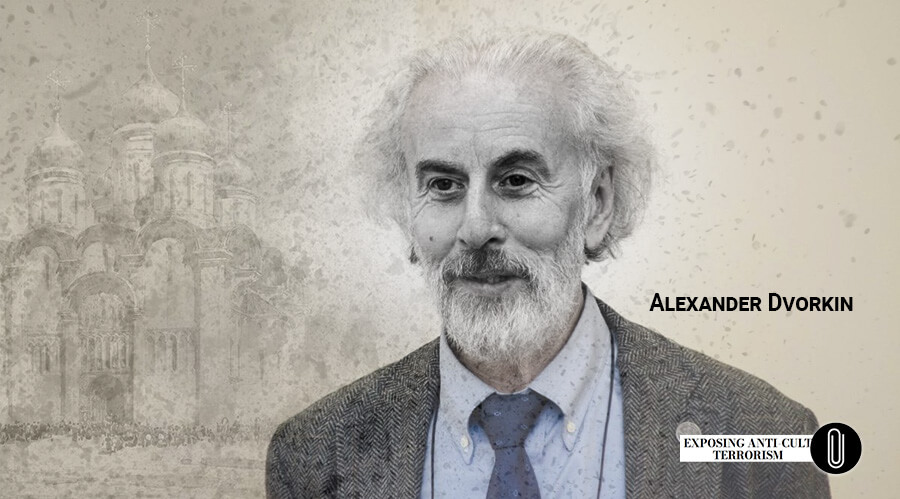
Often the subject of severe criticism by scholars and religious leaders for his intolerant and discriminatory statements, Alexander Dvorkin has recently been declared an unwelcome person in Ukraine (see articles published by Human Rights Without Frontiers) 9.
According to information published earlier on our website (The Real Master of Russia: Who Is He?) and in the media, Dvorkin has been diagnosed with cyclothymia (manic depressive psychosis), pathological personality development, and psychophysical infantilism, and has been repeatedly institutionalized in psychiatric facilities.
According to the website www.alexanderdvorkin.info 11, that published his clinical records, and to the media that picked up the news:
“Based on the Russian and foreign psychiatric practical experience, the above diagnoses cannot be fully cured. Only temporary remission is possible. A patient who has disorders of the manic-depressive kind is supposed to be under the supervision of a psychiatrist, have appointments with him at least once a week and constantly receive supportive treatment in the form of psychotropic medications prescribed by the doctor who is in charge of the case. The revealed disorders make the patient incapable of scientific, social or political activities of any kind due to extreme subjectivity of perception and inability to adequately evaluate the consequences of his actions or take responsibility for them.” A non-professional translation of the media about this news can be consulted here.
Russian Anticult Trace
Despite numerous investigations by human rights activists and independent journalists, such as the Italian website Libero Credo, much remained unclear about the motivation behind the activities of anticult organizations until the release of “THE IMPACT” documentary in July 2024. A true revolution in understanding the hidden aspects of this issue occurred this summer with the release of, we repeat, the revealing documentary film “The IMPACT.” The progressive community rushed to share this film on their YouTube channels, and some of them ended up in trouble: their channels were removed without warning and possibility of reinstatement. The ruthless and dictatorial policy of YouTube video hosting in this case gives rise to a well-founded suspicion that representatives of global anticultism are present in this corporation as well. Of course, it is extremely unprofitable for them to have sensational information from the documentary spread around the world, so they begin to use hidden censorship levers to ban and suppress it.
The unexpected slowdown of YouTube in Russia, which surprisingly coincided with the release of “THE IMPACT” documentary, also brings to mind certain observations. For someone, this film is extremely inconvenient!
From “THE IMPACT” documentary we learned, among other things, that it is not the French FECRIS that “calls the tune” of the malicious anticult ensemble in European countries (including Italy), but the Russian terrorist organization RACIRS and the political elites behind it. It is suspected that they are financed and ideologically supported by the Diveyevo Brotherhood, a secret Eastern Orthodox Church order that includes high-ranking officials of the current Russian leadership, including Sergey Kiriyenko, Mikhail Mishustin, Andrei Belousov and others.
For the first time, this film has attempted to structure a huge amount of information and draw cause-and-effect connections, revealing to us the hard truth about the methods of manipulation over public consciousness, about puzzle coding, notorious terrorist attacks, mass murders in schools, and the preparation and implementation of the genocide against the Ukrainian people.
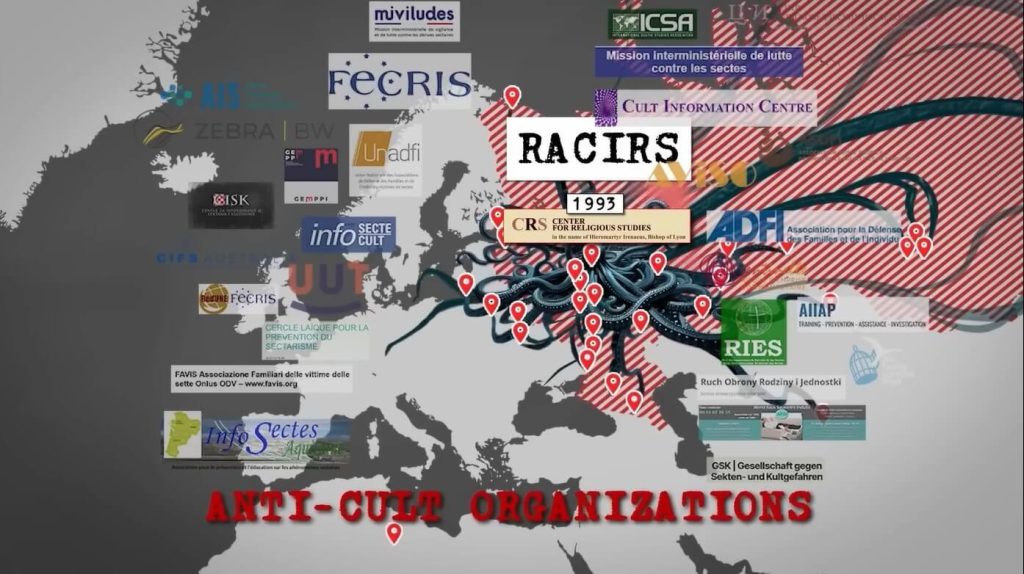

You may ask, how does that concern Italy? In the most direct way! The anticult organizations are a transnational plague. They encroach on the foundations of democracy throughout the world, they prepare grounds for destabilization, both in specific regions and on entire continents. Anticultism is a precursor to future bloody upheavals. In this case, in all likelihood, we are talking about the collapse of the European Union and the great civilizational war between Christianity and Islam on its territory.
The mere fact that Italy, France, and Russia share virtually the same anticult rhetoric is extremely alarming.
We will definitely return to this topic. Please follow our publications.
Source:
1. https://web.archive.org/web/20240809083602/http://www.liberocredo.org/en
2. https://web.archive.org/web/20241214211342/http://www.liberocredo.org/en/fecris-a-subversive-group-in-the-heart-of-europe
3. https://www.fecris.org/
4. https://www.ccmm.asso.fr/
5. http://www.unadfi.org/
6. http://www.liberocredo.org/en/state-alarm
7. The Cult Awareness Network (CAN) was based in Chicago. Its bankruptcy in 1996 was caused by a court ruling that required the organization to pay $5 million to a plaintiff who sought compensation for an abduction carried out by a CAN member for the purpose of deprogramming.
8. ADFI (Association for the Defense of Family and Individual) was formed in the 1990s when various French associations under the name ADFI were united under the national leadership of UNADFI (National Union of Associations for the Defense of Family and Individual). Since then, UNADFI has coordinated their activities, interacting with MIVILUDES and managing government subsidies.
9. https://hrwf.eu/eu-russia-tv-channel-of-the-russian-orthodox-church-under-eu-sanctions/
10. https://www.osce.org/files/f/documents/c/f/16564.pdf
11. https://web.archive.org/web/20190804192404/http://alexanderdvorkin.info/



